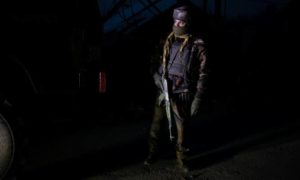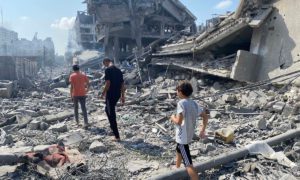The massacre in Jammu seventy one years ago changed the demography of the region by a ruthless state sponsored slaughter of over 2.3 lakh Muslims. Soon after the bloodcurdling fall of 1947 that also consumed over 20 thousand Hindus and Sikhs, policymakers and citizenry began viewing the former Princely State’s other ethno-linguistically and politically distinct provinces through a Kashmir-centric lens. There exist many historical and present-day gaps in Indian, Pakistani, and Kashmiri narratives pertaining to the Jammu region.
The 1947 Jammu Massacre hardly figures into Indian understandings of the Kashmir across the political spectrum. Like the 1948 Police Action of Hyderabad, it is a very watered-down, if not ignored chapter of history.
Little do people remember that prior to partition, the undivided Jammu region—consisting of seven districts of the present-day Azad Kashmir unit and the Jammu part of J&K state—was also engulfed in communal flames. Rarely does any piece of literature or cultural production encompass such overlooked realities, historical and present-day. The Jammu Massacre is just one of many important yet neglected layers of the Gordian Knot that is Kashmir.
Like the atrocities in Jammu, the following books that elaborate on the circumstances before and after the bloodbath are yet to become a part of the mainstream discourse.
Kashmir: The Unwritten History by Christopher Snedden
Tajamul Islam, a PhD Scholar from Bandipora studying at Maulana Azad National Urdu University (MANUU) clarifies, “The Kashmir conflict and struggle did not only start in the Valley, but in Poonch.”
ALSO READ: JammuMassacre@70: The slaughter secret and the military revolt in Poonch
For mainland Indians, the Kashmir timeline commences with the tribal invasion that was thwarted by the Indian military. That too, after Hari Singh “temporarily acceded” to India, despite signing a Standstill Agreement with Pakistan.
For Pakistanis, that their co-religionists who were the majority population of the Princely State are not a part of their Muslim-majority country forms the crux of the conflict. This understanding was/is based on the Two-Nation Theory that laid the basis for the 1947 Partition of the subcontinent.
Politico-strategic analyst Christopher Snedden delves into integral pre-partition happenings and elaborates on the non-Valley, Jammu-based leaders’ contributions—before the Muslim Conference’s dissolution and after its resurrection as a National Conference rival.
Also key is Snedden’s chronicling of how the people of the Poonch Jagir, which included the present day Sudhnoti districts and an unbifurcated Poonch district, wrested their autonomous principality from Dogra rule. This portion came to be called Azad Kashmir after freeing itself not from the Indian or Pakistani state, but from the Maharaja’s regime.
When Western Jammu, the Kashmir Valley’s Muzzafarabad District and the newly free District (barring Eastern Poonch which is currently administered by India) ended up on Pakistan’s side of the ceasefire line, they were together referred to as a political unit called “Azad Kashmir.”
The post-accession trajectory of this province, the Jammu Massacre of Muslims, and subsequent retaliation against Hindus/Sikhs in Mirpur, and a deeper grasp of the anti-Dogra uprising fill glaring voids in Indian and select Kashmiri narratives. Therefore,this should be the first piece of literature that should be consulted for a thorough understanding of the Kashmir dispute.
While addressing the gaps in popular discourse on J&K history, it also calls for unhindered conversations between Kashmiris from both sides to let them decide their fates.
Between the Great Divide: A Journey Into Pakistan-Administered Kashmir by Anam Zakaria
As a primary source and debatably an ideological influence, Christopher Snedden’s influence is apparent in Anam Zakaria’s book. She utilizes her meticulous research and fieldwork to highlight various voices from Azad Kashmir.
Zakaria projects unique voices that find little, if any prominence. These include the nationalist ideology of an Azad Kashmir-based political party–the Jammu Kashmir National Awami Party (JKNAP), solely pro-peace stances of certain women from Neelam Valley, the plight of many Kashmiri Muslims as refugees across the LoC, and pro-Pakistan outlooks from commonfolk/prominent establishment figures.
ALSO READ: JammuMassacre@70: The lady who averted the post-pogrom crisis
While the back cover elucidates on one of the overarching themes of “letting Kashmiris speak, sans intervention,” the prolific researcher and writer clarifies that she does not aim to advocate a certain solution. She instead seeks to disseminate perspectives from ordinary people. Almost all of the interviewees’ real names were not revealed to protect their identities.
The ground level perceptions of many “Azad Kashmiris”regarding many judicial/executive policy matters such as Azad Kashmir’s constitutional status and Pervez Musharraf’s tripartite Four Point Plan are thought-provoking—provided that people genuinely want to hear such perspectives.
Kashmir Conflict and Muslims of Jammu by Zafar Choudhury
“After the 1947 partition and the violence in the state, our crème of Jammu Muslims became entrenched across the LoC and the Punjab border,” says PhD Scholar at MANUU and Poonch native, Attaullah Niazi.
Over the years, however, this larger reality was conveniently brushed aside. Eventually, the Muslim from J&K either became an exotic specimen or a gun-toting militant for the Indian and Pakistani
But in his book, journalist Zafar Choudhury vividly presents the first hand testimonies of those who witnessed the massacres in East Jammu while also acknowledging the gruesome retaliation by Muslims in the province’s western portion.
ALSO READ: JammuMassacre@70: The tale of two migrations
With most of their elite in Pakistan, dwindled numbers due to the 1947 communal riots, and the erstwhile non-Muslim Jammu ruling class playing second fiddle to a new political class from the Valley, this less-talked about minority has always been disenfranchised.
Different stakeholders of the J&K issue have polarized Indian Administered Kashmir into a Hindu Jammu and a Muslim Kashmir Valley. The Doda and Kishtwar districts in Jammu have been hotbeds for militancy, which to a certain extent ties them to the politics of the Kashmir province.
ALSO READ: JammuMassacre@70: When the armed RSS men had a field day
Choudhury accurately recounts how Sheikh Abdullah shrewdly gained a foothold in the politically distinct Jammu province through those districts. As for why Muslims outside those two districts deviate from their Valley co-religionists, the author unearths an unknown occurrence of the 1965 war that saw Muslim youth from Jammu participate in small-scale militancy while Kashmiris didn’t capitalize on Operation Gibraltar as per Zulfikar Ali Bhutto’s plans.
Consequently, many Jammu Muslims alongside the LoC bore the brunt of the Indian army’s brutal crackdowns. Amid the backlash, many of these Muslims believed that Pakistan left them to fend for themselves after assuring them that their divided homeland would be reunited.
If empowered, Zafar Choudhury’s policy recommendations towards the end make one believe that Jammu Muslims can help untie the Gordian Knot. That is only if people see the untapped potential of J&K’s most ignored minority—whose identities were once (before 1947) a very prominent part of East Jammu’s fabric.
Across the LoC: Inside Pakistan Administered Jammu and Kashmir by Luv Puri
Despite being authored by a competent journalist and published by a global publishing name,this book is quite the unsung hero of the J&K conflict literature.
Puri does utilize extensive research, his experiences as a journalist who covered the 2005 earthquakes in Azad Kashmir, and evocative stories of people who fled present-day Indian Administered Kashmir from the 1947 to early 2000. However, there is no prevalence or amplification of a particular perspective via those three lenses.
ALSO READ: JammuMassacre@70: The frenzy of Suraiya, and the silence of history
That is somewhat the case with Zakaria’s and Snedden’s works, as they tend to evaluate many issues and diverse ethno-linguistic identities of J&K as one “Kashmiri” political identity. Yet, they simultaneously remain cognizant about political perspectives that do not cut across the ethno-linguistic fissures of Jammu and Kashmir.
Senior leader of United Kashmir People’s National Party Dr. Amjad Ayub Mirza mentions, “Growing up we were told that we were Kashmiris even though we don’t speak Kashmiri, but rather Punjabi and its Mirpuri dialect spoken in Azad Kashmir. Only later did I realize that ethnically we are Jammuites,” he adds.
Clearly, the ghosts of the East Jammu Massacre as well as the ensuing retaliatory killings in West Jammu still linger. Both bloodbaths have either diluted and/or cluttered diverse identities.
Daneesh Majid is a freelance writer based in Hyderabad. He holds a Masters Degree in South Asian Area Studies from the School of Oriental and African Studies, University of London. His work has been featured in major publications including The Wire India, The New Indian Express, The Hindu Business Line – Ink, Express Tribune, and The Friday Times.
Like this story? Producing quality journalism costs. Make a Donation & help keep our work going.






